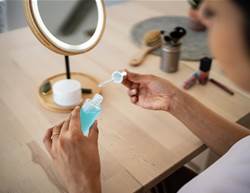If you pull any product out of your beauty draw and attempt to read the ingredients list, there will probably be a few words that you won’t know how to pronounce – let alone what they do to your skin.
More and more brands are creating ‘not allowed’ lists with thousands of harmful ingredients and chemicals that won’t be included in their ranges.
If you have sensitive skin or are looking to make your skincare regimen a little less toxic, watch out for these 10 common ingredients.
Butylated hydroxytoluene (BHT)/ Butylated hydroxyanisole (BHA)
Petroleum-derived antioxidants used to extend shelf life of products, BHA and BHT can induce allergic reactions in skin. They may also be carcinogens and hormone disruptors.
Parabens
Some parabens have been linked to endocrine disruption, which may increase the risk of certain cancers. Therefore, beware of parabens, including ethylparaben, butylparaben, isobutylparaben, isopropylparaben methylparaben, and propylparaben.
Petrolatum
Commonly known as petroleum jelly, petrolatum is a skin protectant that is a by-product of petroleum. It typically contains the impurity polycyclic aromatic hydrocarbons (PAHs) which have been linked to cancer.
Phthalates
Phthalates (i.e. dibutylphthalate (DBP), dimethylphthalate (DMP), diethylphthalate (DEP)) are plasticising ingredients commonly used in fragrances as a solvent and skin fixative. Phthalates have been linked to endocrine disruption and may cause birth defects.
Synthetic fragrance and dyes
Since many synthetic fragrances and dyes are petroleum-derived, they may contain components which are potential hormone disruptors, allergens, and environmental toxins.
Sodium laureth sulphate (SLES) and sodium lauryl sulphate (SLS)
These are harsh surfactants that can cause skin irritation or allergic reactions. Moreover, SLES often contains the impurity 1,4-dioxane, a by-product from its manufacturing process, which is a potential carcinogen.
Triclosan
This is an antibacterial agent which causes skin irritation and has been linked to endocrine disruption. It is also bioaccumulative and potentially toxic to aquatic organisms.
Ethanolamines (MEA/DEA/TEA)
These are frequently used in cosmetics as emulsifiers, foaming agents or pH adjusters. Based on studies, they are linked to organ system toxicity, cancer, and environmental concerns of bioaccumulation.
Talc
Talc is used in cosmetics as an anticaking or bulking agent. Talc can be contaminated with asbestos fibres which possess risks for respiratory toxicity and cancer.
Hydroquinone
Hydroquinone is a skin lightener which can cause skin irritation and may be linked to certain cancers.










